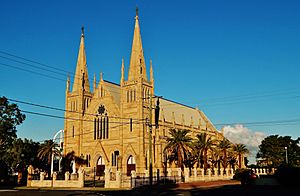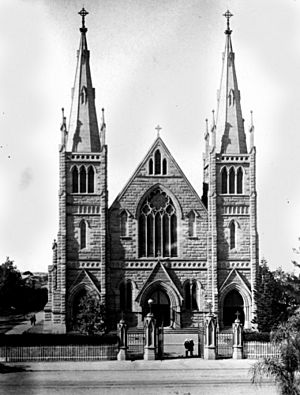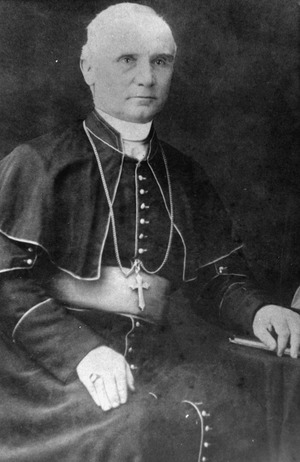St Joseph's Cathedral, Rockhampton facts for kids
Quick facts for kids St Joseph's Cathedral, Rockhampton |
|
|---|---|
| Cathedral of Saint Joseph | |

St Joseph's Cathedral, 2020
|
|
| Location | Rockhampton, Queensland |
| Country | Australia |
| Denomination | Catholic Church |
| History | |
| Status | Cathedral (since 1893) Church (1863–1892) |
| Founded | 11 June 1894 |
| Consecrated | 15 October 1899 |
| Architecture | |
| Functional status | Active |
| Heritage designation | Queensland Heritage Register |
| Designated | 21 October 1992 |
| Architect(s) | Francis Drummond Greville Stanley |
| Architectural type | Church |
| Style | Neo-Gothic |
| Years built | 1893–1982 |
| Groundbreaking | 1896 |
| Completed | 1982 |
| Administration | |
| Archdiocese | Brisbane |
| Diocese | Rockhampton |
| St Joseph's Cathedral, Rockhampton | |
|---|---|
| Lua error in Module:Location_map at line 420: attempt to index field 'wikibase' (a nil value). | |
| Location | 170 William Street, Allenstown, Rockhampton, Rockhampton Region, Queensland, Australia |
| Design period | 1870s–1890s (late 19th century) |
| Built | 1893–1982 |
| Architect | Francis Drummond Greville Stanley |
| Architectural style(s) | Gothic |
| Official name: St Josephs Cathedral | |
| Type | state heritage (built) |
| Designated | 21 October 1992 |
| Reference no. | 600822 |
| Significant period | 1890s, 1980s (historical) 1890s–1900s, 1980s (fabric) ongoing (social) |
| Significant components | tower, cathedral, views to, furniture/fittings, stained glass window/s |
St Joseph's Cathedral is a beautiful and historic Roman Catholic church located in Rockhampton, Queensland, Australia. It is a special type of church called a cathedral, which is the main church for a Bishop. This amazing building was designed by Francis Drummond Greville Stanley and built over many years, from 1893 to 1982. It is so important that it was added to the Queensland Heritage Register on 21 October 1992.
Contents
The Story of St Joseph's Cathedral
The first official Roman Catholic church service in Rockhampton happened in May 1862. Two priests, Father James Scully and Father Patrick Duhig, came to visit. They held Mass in the local Court House for about fifty people. During their visit, they started collecting money to build a church.
Building the First Church
The first church, dedicated to St Joseph, opened on 4 January 1863. It was located on the corner of Derby and Alma Streets. Father Charles Murlay was put in charge of the Rockhampton area. His parish was huge, stretching from Gladstone to Townsville!
Planning a Grand Cathedral
In 1876, Bishop James Quinn suggested that Rockhampton needed a bigger, more important church. This was because the area was going to become its own Diocese. Land was bought in William Street by February 1877. By 1883, the community had raised £4000 for the new cathedral.
On 21 May 1882, Bishop John Cani became the first Bishop of Rockhampton. He was very keen to get the new cathedral built.
Construction Begins
The plans for the cathedral were drawn up by famous Brisbane architects, FDG Stanley and Son. Francis Drummond Greville Stanley designed many important churches in Queensland. Construction of St Joseph's Cathedral began on 11 June 1894. Bishop Cani laid the foundation stone on 17 March 1895. The stone for the building came from Stanwell Quarry, which was owned by Bishop Cani himself.
Completing the Cathedral
Sadly, Bishop Cani passed away on 3 March 1898, before the cathedral was finished. It was a tradition to bury a bishop inside his cathedral. So, Bishop Cani was first buried temporarily in the Rockhampton Cemetery. The plan was to move him to the cathedral once it was ready.
Bishop Joseph Higgins arrived on 20 July 1899. The cathedral was still not fully complete. Local architects, Eaton and Bates, helped finish the final part of the building. On 15 October 1899, a big opening ceremony was held. Cardinal Patrick Francis Moran from Sydney celebrated a special Mass.
On 22 July 1902, Bishop Cani's remains were moved and re-buried inside St Joseph's Cathedral. His tomb is under a special window dedicated to him.
Updates and Renovations
Over the years, the cathedral has had several important updates. In 1918, the church's outer supports, called flying buttresses, were strengthened. In 1980, it was discovered that a temporary wall from 1899 was not safe. A project began to finally complete the building properly.
On 22 May 1982, Cardinal Sir James Darcy Freeman from Sydney dedicated the fully completed cathedral. In 1987, the beautiful stained glass windows were sent to England for restoration. They were carefully cleaned and repaired before being returned to St Joseph's Cathedral.
What St Joseph's Cathedral Looks Like
St Joseph's Roman Catholic Cathedral is a large building made of sandstone. If you look at it from above, it has a traditional cross shape. It has a long main hall called a nave, with smaller sections on the sides called aisles. There are also two side sections called transepts and a rounded area at the back called an apse. Two tall towers stand at the front of the building.
Outside the Cathedral
The front of the building is very grand and balanced. It has a main entrance with a pointed arch. Above the entrance is a large window with detailed stone patterns. The two towers have pointed tops, called broach spires, made of sandstone. The stone used for the building is rough, but the details around windows and doors are smooth.
Inside the Cathedral
The inside of the church is designed in a traditional way. The main hall (nave) is separated from the side aisles by a series of pointed arches. Near the entrance, there is a special area called a narthex, also separated by arches. The arches are made of smooth sandstone and have simple round columns with decorative tops.
The ceiling is shaped like a shallow pointed arch and is covered with wooden boards. It has large wooden arch-shaped beams. High up on the walls, there are groups of three pointed arched windows. These windows let in light to the main part of the church. At the front, there is a gallery (a raised seating area) above the narthex.
St Joseph's Cathedral has many beautiful features inside. The floor is made of black and white Italian marble tiles, arranged in a checkerboard pattern. There are also many stunning stained glass windows. These windows show scenes from the New Testament and were made by John Hardman and Son in England.
Why St Joseph's Cathedral is Important
St Joseph's Cathedral was added to the Queensland Heritage Register on 21 October 1992. This means it is a very important historical site.
A Glimpse into Queensland's Past
The cathedral shows how much Rockhampton grew in the late 1800s. It was built as the first Roman Catholic Cathedral in Rockhampton. This happened after the Rockhampton Diocese was created in 1882.
A Great Example of Gothic Revival Style
The building is a wonderful example of Gothic Revival style. This style includes sandstone construction, a cross-shaped plan, Gothic decorations, a steep roof, towers with spires, and beautiful stained glass windows.
Beautiful and Recognizable
The cathedral is a very well-designed building. It is also a famous landmark in Rockhampton, meaning it's a well-known and important part of the city's skyline.
Special Meaning for the Community
The cathedral holds a very special place for the Roman Catholic community in central and north Queensland. It is their main church and a place of great spiritual importance.
Connected to Important People
The building is linked to the famous architect, FDG Stanley. It is also connected to many important bishops of the Rockhampton Diocese who have served there over the years.
See also
 In Spanish: Catedral de San José (Rockhampton) para niños
In Spanish: Catedral de San José (Rockhampton) para niños



